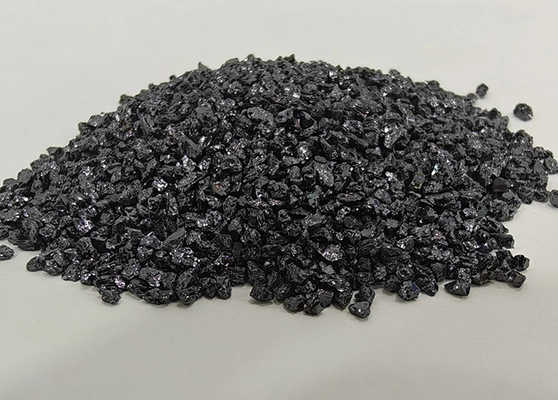Quick Answer: Carborundum is the trade name for silicon carbide (SiC), a synthetic crystal created by fusing silica sand and carbon at high temperature. It exists as shiny, iridescent crystals and is also ground into carborundum powder, which is widely used as an abrasive for grinding, polishing, and industrial applications.
Carborundum Meaning
The word carborundum was originally coined in the late 19th century as a brand name for silicon carbide abrasives manufactured by the Carborundum Company in the United States. Over time, the term became synonymous with silicon carbide itself. Today, "carborundum" generally refers to SiC in crystal, stone, or powder form, valued for its extreme hardness (Mohs 9.0–9.5) and thermal resistance.
Carborundum Crystal
Carborundum crystal is produced in electric resistance furnaces and often displays rainbow-like iridescence due to its unique structure. Beyond industrial use, carborundum crystals are also collected for metaphysical purposes, as some believe they promote grounding, protection, and energy balancing.
- Appearance: Sparkling, metallic, often multi-colored surface.
- Hardness: ~9 on the Mohs scale, almost as hard as diamond.
- Uses: Abrasives, ceramics, semiconductors, and decorative or healing stones.
Carborundum Powder
Carborundum powder is finely ground silicon carbide, available in a wide range of grit sizes. It is one of the most important industrial abrasives, offering sharp cutting ability and excellent wear resistance.
Main Applications
- Grinding & Polishing: For metals, stones, glass, and ceramics.
- Lapidary Work: Cutting and shaping gemstones.
- Industrial Finishing: Surface preparation, deburring, and polishing components.
- Refractory Use: As an additive in high-temperature ceramics and furnace linings.
Carborundum Crystal vs. Carborundum Powder
| Form | Properties | Common Uses |
|---|---|---|
| Carborundum Crystal | Solid, iridescent, high hardness, stable at extreme heat | Collectibles, semiconductors, abrasives, metaphysical uses |
| Carborundum Powder | Fine grit, sharp cutting edges, available in F/P grit sizes | Grinding, polishing, lapidary, industrial finishing, refractory |
FAQs About Carborundum
1. What does carborundum mean?
Carborundum is the trade name for silicon carbide, a synthetic compound valued as one of the hardest known materials and widely used as an abrasive.
2. Is carborundum natural or man-made?
Carborundum (silicon carbide) is man-made. Although small amounts occur naturally as the mineral moissanite, industrial carborundum is produced synthetically in furnaces.
3. What is the difference between carborundum crystal and powder?
Carborundum crystal is a solid iridescent form, while carborundum powder is ground silicon carbide used as an abrasive in many industries.
4. What grit sizes are available in carborundum powder?
Powder is graded by FEPA/ANSI standards, ranging from coarse grit (F16–F220) to micro powder (F240–F1200) for fine polishing.
Conclusion
Carborundum meaning goes beyond a brand name—it represents silicon carbide in its many forms. From shimmering carborundum crystals admired for their strength and energy to finely milled carborundum powder used in global industries, this remarkable material continues to shape modern manufacturing and technology.
Learn more about our abrasives: Black Silicon Carbide, Brown Fused Alumina, and Silicon Carbide Powder Price.
Request a Quote or Sample
Popular Products
Grünes Siliziumkarbid
View DetailsSchwarzes Siliziumkarbid
View Details